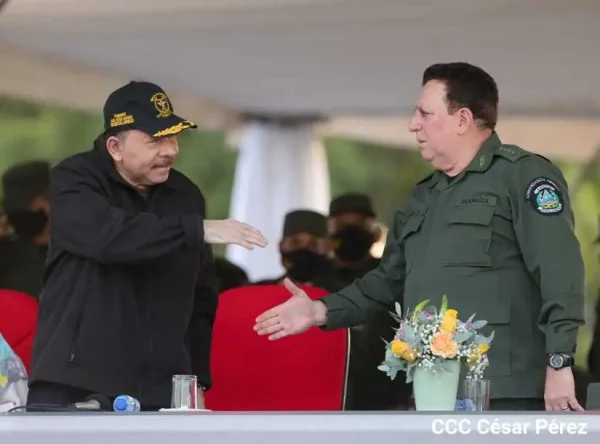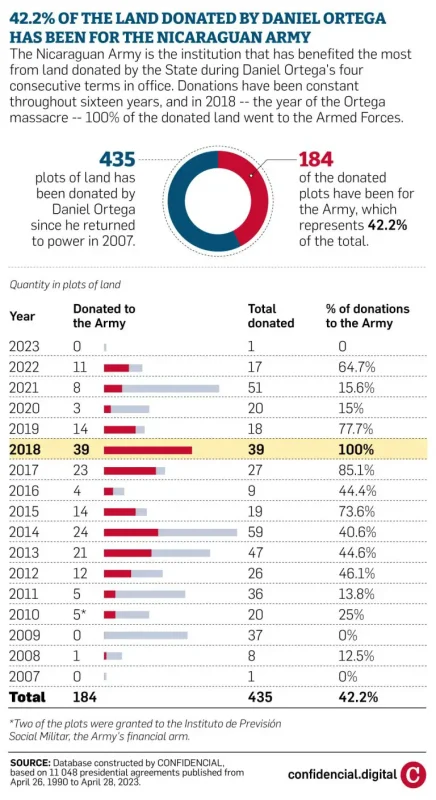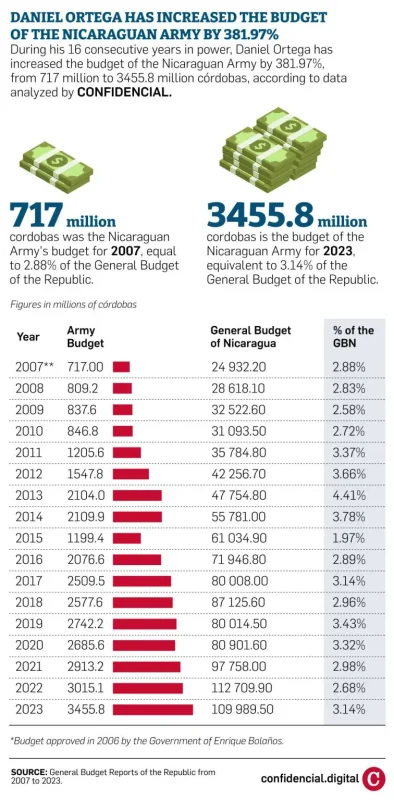Ortega Rewards Nicaraguan Army Loyalty with Real Estate

In his four consecutive administrations, Ortega has given out a total of 435 plots of land. Of these, 184 (42%) have been given to the military
HAVANA TIMES – During these last sixteen years in power, Daniel Ortega has bought the loyalty of the Nicaraguan military leadership by transferring to the Armed Forces almost a hundred properties and increasing its millionaire budget, reveals investigative reporting by Confidencial.
The investigation found that the Army is the institution that has benefited the most from donations of properties by Ortega.
In his four consecutive administrations, the President has given out a total of 435 plots of land. Of these, 184 –or 42%– have been given to the military.
Confidencial gathered, processed, and analyzed a database containing information on all the properties handed out by Ortega, as well as those handed out during the administrations of Enrique Bolaños, Arnoldo Alemán, and Violeta Barrios de Chamorro. A total of 11,041 presidential agreements were reviewed, having been published in 8,083 official Gazettes between April 26, 1990, and March 31, 2023.
The 184 plots donated to the Army comprise some 97 properties, totaling more than 41 million square meters or 4,127 hectares, equivalent to more than 5,778 soccer fields.
The donations range from a small lot of 5.45 square meters to a single property of 13.6 million square meters.
The properties are located mainly in urban areas of Managua, 14 provinces, and the two autonomous Nicaraguan Caribbean regions.
Ortega donated properties to the Army for 12 consecutive years between 2010 to 2022.

The generosity of the Sandinista leader contrasts with that of the governments of Violeta Barrios de Chamorro, Arnoldo Alemán, and Enrique Bolaños, who did not donate a single plot or property to the Army.
CONFIDENCIAL asked former military personnel as well as national security experts: Does the Army need the properties in its name in order to carry out its functions? The answer was a resounding “NO.”
“The military wants [the properties] to increase their wealth and capital. It makes them stronger and stronger, more in the sense of a business group than in terms of military capabilities,” explained one expert.
The military’s businesses are managed by the Military Social Welfare Institute, which is the Army’s business arm. In 2012, its funds were estimated at between US$90 million and US$100 million.
For the researchers, the “handover of properties” to the Army is also related to its institutional development and investment plan, in which the properties can serve, in the future, as “collateral” for loans to shore up the Army’s investments.
In its investigation, Confidencial verified in situ at least 69 properties, totaling some 152 plots.
Of the 69 properties reviewed, at least 22 –some 28 plots– are not being used for exclusively military purposes, as there are no Army troops or facilities on them. Rather, researchers observed empty houses, vacant lots, and wooded areas.
One of the experts suggests that the lack of military infrastructure on these plots could indicate that these properties may be intended for something other than military purposes in the future.
There are 47 properties –some 124 lots – that are being used exclusively for military purposes, including several command headquarters, bases, and military training centers, as well as administrative offices.
These properties have been in the Army’s hands since the 1980s, but with the arrival of Ortega, they began to be legally transferred and put in the name of the Armed Forces.
The areas being used for military purposes also include plots for the installation of antennas, control and border posts, refueling areas, protocol houses, warehouses, or areas for the Navy, as observed by CONFIDENCIAL in the on-site verification.
The biggest property is the Punta Huete airport –popularly called “Panchito”– located in the municipality of San Francisco Libre, some 70 kilometers northwest of Managua.
The property has been donated in pieces, lot by lot. It contains 64 parcels totaling 15.5 million square meters or 1,560 hectares.
According to a real estate broker, each 7,000 square meter plot of land (known as a “manzana” in Nicaragua) in San Francisco Libre is priced at a minimum of US$2,500. Based on that calculation, the value of the donated lots totals some US$5.5 million.
The runway and airport were built in the 1980s, with the supposed purpose of Russian MiG-21 fighter planes landing and taking off there. These planes never arrived in Nicaragua.
Along with the turning over of these properties to the Armed Forces, the regime has almost quadrupled the military budget, going from 717 million cordobas in 2007 to more than 3 billion, 455 million cordobas in 2023. There was a 14.3% increase just between 2022 and 2023.
The largest budget increases started in 2010, a year after Ortega appointed General Julio César Avilés, who has now been in the post for 13 years, as head of the Army. Since then, the budget has more than tripled.

With Ortega in power, there has also been a growth in military personnel, reaching the highest number since the end of the civil war and the establishment of democracy in 1990.
When Ortega won the presidency in 2006, the number of military personnel was 10,553. By 2023, the figure has reached 15,705. These more than 5,000 additional troops represent a 49% increase during Ortega’s tenure.
The biggest increases happened in 2011 and 2016, presidential election years in which Ortega orchestrated electoral fraud to stay in power, and between 2018 and 2019, the harshest stages of direct repression of the population after the civic uprising of April 2018.
Researchers, national security experts, and ex-military personnel agreed that there is an exchange between the military and Ortega, in which the Army receives property, more troops, and a large budget allocation in return for the dictator obtaining “military submission”.
“There is a preferential treatment with the Army, from which the Army obviously benefits, but also the Government. It is a quid pro quo,” said one of the analysts.
The Nicaraguan Army is led by Julio César Avilés and his closest circle. There are ten generals who administer this preferential system, headed by Major General Bayardo Ramón Rodríguez, Chief of Staff, followed by Major General Marvin Elías Corrales Rodríguez (Inspector General), Brigadier Generals Spiro Bassi Aguilar, Bayardo Pulido Ortiz, Leonel Gutiérrez López, Juan José Membreño, Oswaldo Barahona Castro, Guillermo Patricio López, Héctor Argüello Aguirre, and Colonel José Hilcias Rizo Rizo.





